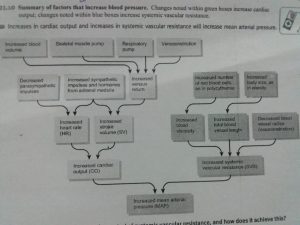Blood Pressure and the factors affecting BP and MCQs With Answers
Blood pressure is defined as the hydrostatic pressure exerted by the blood on the walls of a blood vessel. It is generated because of the contraction of ventricles.
It is highest in aorta and in large systemic arteries. There are two types of blood pressure, the systolic blood pressure which is the highest pressure in arteries during systole and the other one is the diastolic blood pressure which is the lowest BP during diastole (relaxation).
As the blood leaves from aorta, the BP starts decreasing due to the increase in the distance from the left ventricle, in capillaries the BP drops to 16 mm Hg and when the blood return back to the right atrium, The BP drops to 0 mm Hg.
The average blood pressure in arteries is termed as MEAN ARTERIAL PRESSURE, its formula is
Mean Arterial Pressure
MAP= diastolic BP+1/3(systolic BP – diastolic BP)
Or
MAP= cardiac output * resistance
So if we are supposed to find the factors affecting BP, then these are the factors which affect the cardiac output and resistance.
Factors affecting BLOOD PRESSURE
Four major factors are-
1. Stroke volume – it is the amount of blood ejected from the left ventricle, if stroke volume increases the cardiac output increases which in turn increases BP. Stroke volume is increased when preload and contractility increases and stroke volume decreases when afterload increases.
2. Heart rate- cardiac output is directly proportional to cardiac output and if it increases during increased body temp, increased amount of epinephrine and non epinephrine, during exercise, increased amount of Ca ions etc.
3. Vascular resistance – it depends on 3 factors,
• the size of lumen: smaller the size of lumen more is the resistance and higher is the BP.
• Blood viscosity(thickness): higher the viscosity higher is the resistance in the flow of blood
• Length of blood vessel : greater the length of blood vessel more is the vascular resistance.
4. Venous return – It is defined as the volume of blood that returns back to heart. If the pressure in the right side of the blood increases, the venous return will decreases and the cardiac output will be less.
The below mentioned flow chart summarizes the factors affecting blood pressure.

MULTIPLE CHOICE QUESTIONS (MCQs)
1. What is responsible for generating BP?
A. contraction of atria B. contraction of ventricles
c. relaxation of atria D. relaxation of ventricles
2. What is the normal BP range?
A. 120/80 mm Hg B. 110/70 mm Hg
C. 130/70 mmHg D. 150/100 mmHg
3. Which device is used to measure BP?
A. electrocardiograph B. sphygmomanometer
C. pulse recorder d. none of the above
4. Match the following
1. Regulated BP in brain (a) causes vasodilation and BP
decrease
2. regulate systemic BP (b)aortic reflex
3. Antidiurectic hormone(ADH) (c) vasoconstriction leads
To BP increase
4. Atrial natriuretic peptide(ANP) (d) carotid sinus reflex
5. Which of the following factors increases BP?
A. higher viscosity B. vasoconstriction
C. increased heart rate D. all of the above
6. Which of the following statement is true?
A. parasympathetic stimulation to the heart is send through vagus nerve
B. Longer the blood vessel lesser is the resistance
C. Proprioceptors measure the blood pressure
D. BP reaches 16 mmHg when blood reaches right ventricle.
7. What happens when the decrease in blood volume is greater than 10%?
A. BP decreases B. BP increases
C. BP remains constant D. BP increases on decrease at higher %
8. What do you mean by systolic BP?
A. Force exerted on the walls during ventricular contraction
B. force exerted on the walls during ventricular relaxation
c. force exerted on the walls during atrial contraction
D. Force exerted on the walls during atrial relaxation
9. Mean arterial pressure (MAP) is equal to?
A. cardiac output* resistance B. Cardiac output*stroke volume
C. resistance *heart rate D. Heart rate * pulse rate
10. Which of the following factors decreases BP?
A. Vasoconstriction B. release of antidiuretic hormone (ADH)
C. increased blood volume D. None of the above
ANSWERS:-
1. contraction of ventricles
2. 120/80 mmHg
3. Sphygmomanometer
4. 1- d 2 – b 3- c 4 – a
5. all of the above
6. longer the blood vessel greater is the resistance
7. BP decreases
8. force exerted on the walls during ventricular contraction
9. cardiac output*resistance
10. none of the above
Participate in Online FREE GPAT TEST: CLICK HERE
Participate in Online FREE Pharmacist TEST: CLICK HERE
Participate in Online FREE Drug Inspector TEST: CLICK HERE
REFERENCES:-Gerard J. Tortora -Principles of anatomy and physiology; edition twelfth ; page no.-: 772-775.